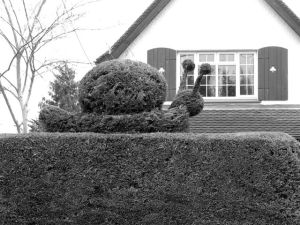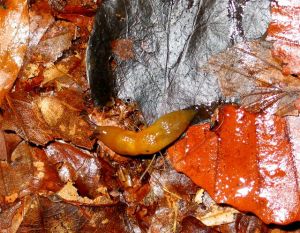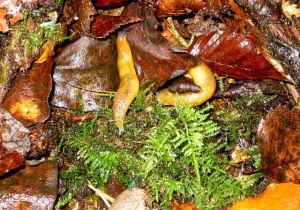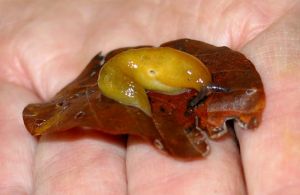|
The fortuitous combination of a request to arrange a field meeting for the Society, and the notification by Tony and Val Marshall of the finding of Malacolimax tenellus in leaf litter in their local wood – subsequently backed up with the record complete with photograph – enabled the organisation of a field meeting to Angling Spring Wood near Great Missenden. Angling Spring Wood SP 8861 0099 is predominantly an old beech wood of 41 acres with some mixed planting, managed until recently by Chiltern District Council and now by local wildlife groups. The soil is mainly clay with flints overlaying Chalk. The wood has steep slopes within it facing north and south either side of a central ride running east/west. The majority of the mature woodland lies to the north of the ride where Val’s specimen had been collected. The Field Meeting was arranged specifically to survey for Malacolimax tenellus and Limax cinereoniger. However it was not just ConchSoc members who were involved. Val and Tony had contacted the local mycologists, the Bucks Fungus Group (BFG), and Prestwood Nature (PN), and so a party comprising Liz Biles, Ron Boyce, Christine and Pryce Buckle, Penny Cullington (BFG), Rosemary Hill, Jan Light, Val and Tony Marshall, Derek Schafer (BFG) and Peter Topley, set out from the Marshall’s home to rendezvous with Mary Ghullam, and PN members, Avril McOmish, Jill and Ross McVean, Jenny Smith, Colin Simpkins and Ian Taylor in the middle of the wood. After introductions, the distribution of maps of the wood drawn up by Tony, and the Health and Safety briefing, Tony led the way to the area of old beechwood to the north of the ride (Compartment K). When, and if, another specimen of Malacolimax tenellus could be found and everyone had had an opportunity to familiarise themselves with it, the plan was to survey the rest of the wood and, in particular, to see if the slug survived in the newer, disturbed part of the wood on the north-facing slopes (Compartment M). Before leaving the central ride Tony pointed out the uncommon species Wood Small Reed (Calamagrostis epigejos), but once up amongst the mature beech the group fanned out and the logrolling and teasing of leaf litter began. A variety of woodland mollusc species turned up including Oxychilus alliarius, which intrigued the mycologists who frequently use smell to help identify specimens. Rain in the preceding week meant that conditions were damp enough in the wood not to disappoint the mycologists and it was a nibbled specimen of Collybia butyracea (Butter Cap) that caught Rosemary’s eye. Upon careful searching through the surrounding leaf litter, Rosemary came up with the first specimen of Malacolimax tenellus of the day. The slug was examined carefully for its distinguishing features; its bright yellow colour, lilac tentacles, short keel, yellow body mucous and the pneumostome to the rear of the mantle. Several specimens were subsequently found in Compartment K though not exclusively in association with fungi and some of them, despite the bright sunshine, grazing the surface of rotting logs. It is worth mentioning here that two specimens of Limax cinereoniger were also found in this part of the wood. When it came to surveying Compartment M where there were younger beech trees, several specimens of M tenellus were found, on the lower slopes where the leaf litter was deep and there were several fallen trees and reasonable quantities of dead timber. One particular fallen beech had fifteen specimens crawling over the surface of the trunk with only moss and microfungi present. However specimens were also found higher up the slope close to the larch plantation where in one instance a single specimen was feeding on Collybia butyracea underneath Holly (Ilex sp). Three more specimens were found at the top of the slope where young beech trees predominated, but interspersed with mature trees. Altogether the morning yielded the following species: Cochlicopa lubricella, Discus rotundatus, Arion ater (agg), Arion subfuscus, Arion distinctus, Arion intermedius, Aegopinella nitidula (shell only), Oxychilus cellarius, Oxychilus alliarius, Boettgerilla pallens, Limax maximus (considerable colour variation was noted throughout the wood), Limax cinereoniger, Malacolimax tenellus, Euconulus fulvus L seg, Deroceras reticulatum and Cepaea nemoralis. After lunch, at the invitation of Prestwood Nature, a smaller group went to Prestwood Picnic Site, an exposed steep Chalk grassland site with some areas of eroded chalk but otherwise a good covering of chalkland flora, in the hope of finding Abida secale. No live specimens were found and it was suggested that those shells found on the surface might well be the result of rabbits burrowing into the hillside. The site however yielded the following: Cochlicopa lubrica, Cochlicopa lubricella, Abida secale, Vallonia costata, Vallonia excentrica, Vitrea contracta, Aegopinella nitidula juvenile, Candidula intersecta, Cernuella virgata, Monarcha cantiana, Cepaea nemoralis and Helix aspersa. Another delightful find at this site was one of the Birds Nest Fungi, Cyathus olla. The Saturday was rounded off with a half hour visit to the churchyard of Holy Trinity Church at Prestwood where no less than twenty-two different species of fungi were recorded, including many of the ‘wax caps’ that seem to find churchyard environments so amenable. On 23rd October, a smaller party still, consisting of Liz Biles, Ron Boyce, Penny Culllington, Rosemary Hill, Jan Light, Derek Schafer, Peter and Sarah Topley, joined the Herts Fungus Group and members of the British Mycological Society (BMS) for their annual memorial foray at the 5000 acre Ashridge Estate run by the National Trust SP 971 131. Alan Outen (BMS), who was leading the foray, very kindly allowed me to talk a little about the slender slug and ConchSoc and, although only a small area of predominantly beechwood was surveyed, thanks to the combined efforts of ConchSoc members and the mycologists, Malacolimax tenellus were found feeding under mature beech, in leaf litter with Russula ochroleuca and Laccaria amethystina, on a rotten beech log when Limax cinereoniger was also present, in deep leaf litter under young beech saplings, with Entoloma sp, with Clitocybe nebularis, under beech with Telamonia (Cortinarius) sp and Mycena crocata. A specimen was found during the afternoon foray amongst the conifers, feeding on Boletus badius. Time was limited at this site but the following species were recorded: Discus rotundatus, Arion ater (agg), Arion subfuscus (seen eating a wide range of fungi, Arion hortensis, Arion intermedius, Nesovitrea hammonis, Aegopinella nitidula, Oxychilus alliarius, Oxychilus helveticus, Limax maximus, Limax cinereoniger, Malacolimax tenellus, Lehmannia marginata, Deroceras reticulatum, Trichia striolata, Arianta arbustorum, and Cepaea nemoralis. All in all this proved a very informative weekend and a useful collaborative exercise. My thanks go to ConchSoc members who were so good and patient at helping nonmembers, passing on their identification skills, and for submitting their records for me to include with this article. A copy of the records made for Angling Spring Wood has been sent to Chiltern District Council. Thank you too to Tony and Val who set the ball rolling and were so helpful throughout. |
Fig 1 Home of Tony Marshall (Photo Liz Biles)
Fig 2 Malacolinax tenellus (Photo Ron Boyce & Rosemary Hill)
Fig 3 Malacolinax tenellus (Photo Ron Boyce & Rosemary Hill)
Fig 4 Malacolinax tenellus (Photo Ron Boyce & Rosemary Hill) |
Field Meeting Report: Angling Spring Wood and Ashfield Estate (22 – 23 October 2005)
Issue
10
Page
3




